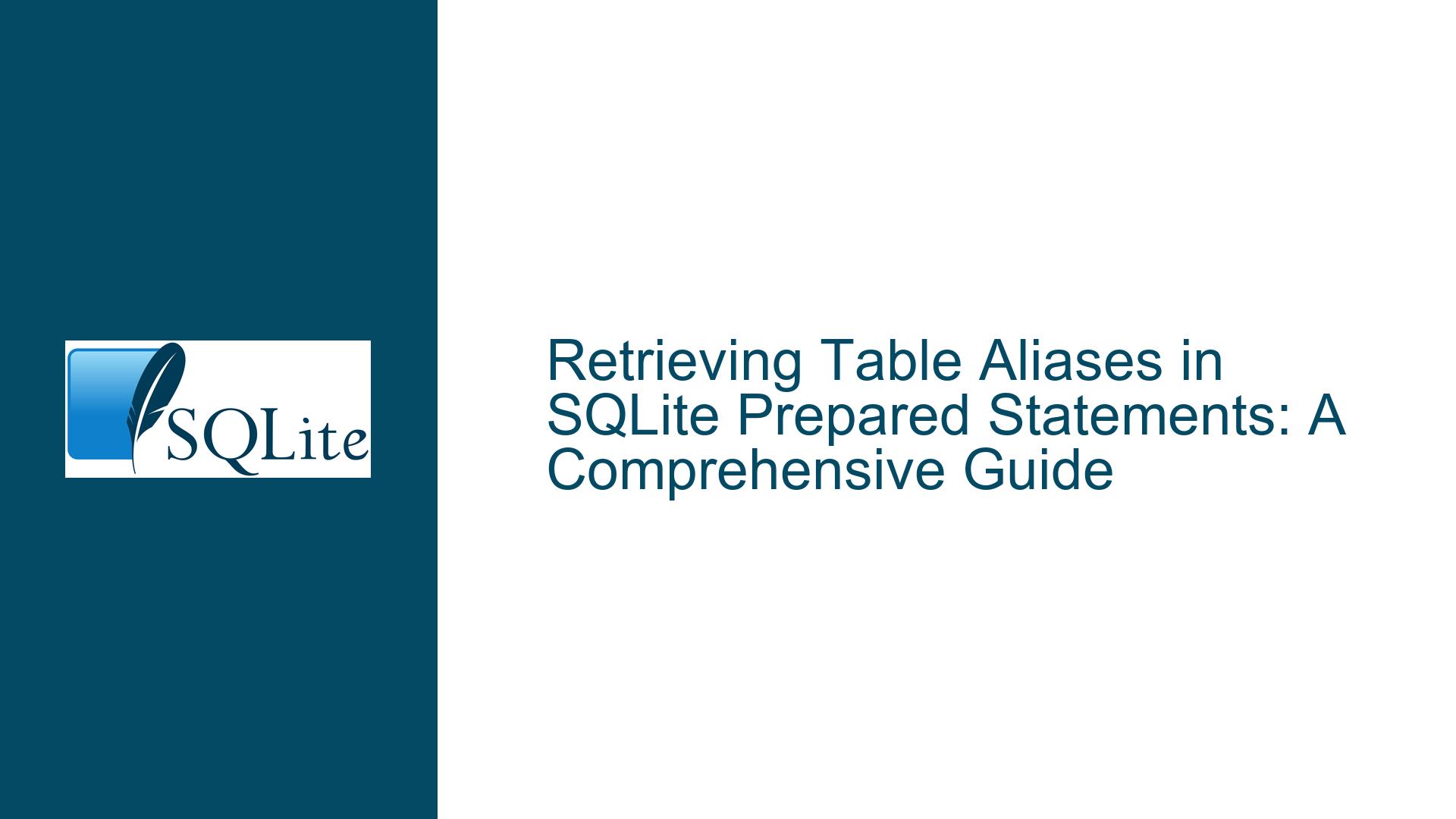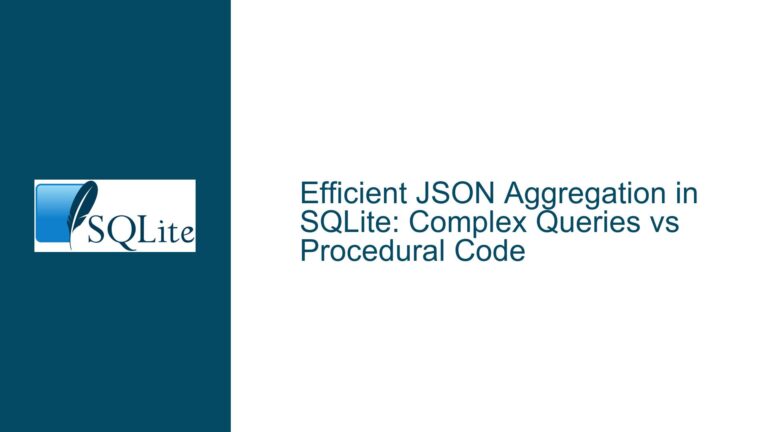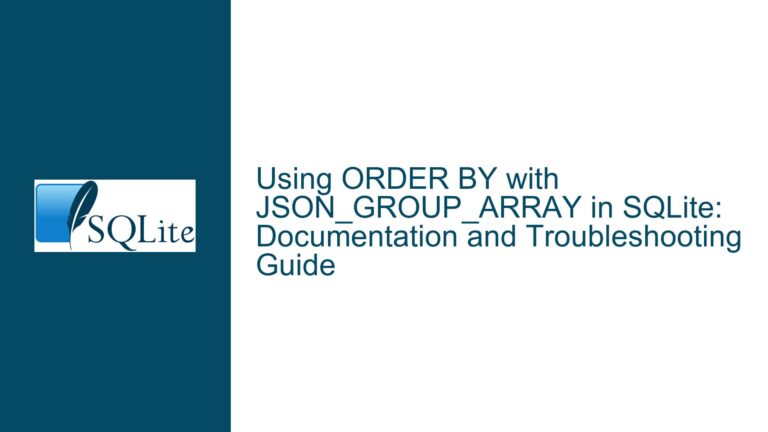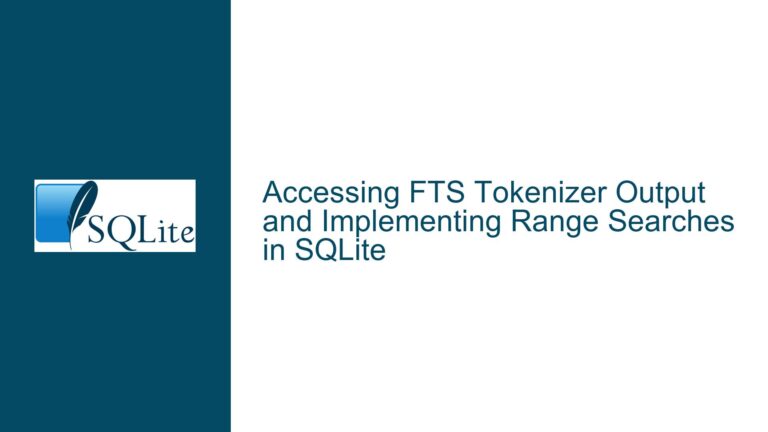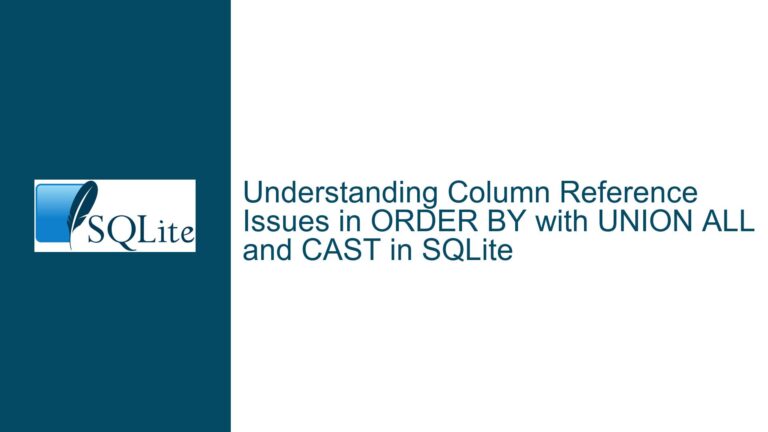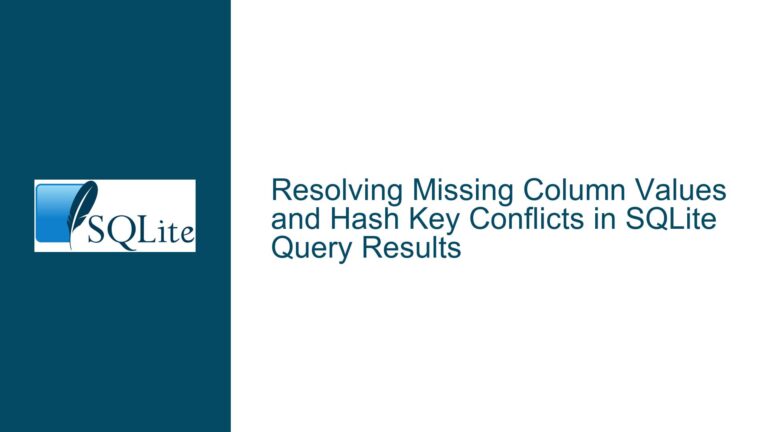Retrieving Table Aliases in SQLite Prepared Statements: A Comprehensive Guide
Understanding the Need for Table Alias Retrieval in SQLite
SQLite is a powerful, lightweight database engine that is widely used in applications ranging from mobile apps to embedded systems. One of its strengths lies in its simplicity and flexibility, but this simplicity can sometimes lead to limitations in certain advanced use cases. One such limitation is the inability to retrieve table aliases directly from prepared statements. This issue has been a point of discussion among developers for nearly a decade, with multiple feature requests and patches proposed to address it.
The core of the problem lies in the fact that while SQLite provides functions to retrieve the original table name, database name, and column origin name from a prepared statement, it does not offer a built-in method to retrieve the table alias specified in the query. This limitation becomes particularly problematic in scenarios involving complex queries with multiple joins, where table aliases are used to disambiguate columns from different tables.
For example, consider a query like this:
SELECT a.id, b.name
FROM users AS a
JOIN profiles AS b
ON a.profile_id = b.id;
In this query, a and b are table aliases. While SQLite can tell you that a.id comes from the users table and b.name comes from the profiles table, it cannot directly tell you that a is the alias for users and b is the alias for profiles. This information is crucial in certain applications, especially when dynamically generating queries or when interfacing with other systems that expect specific naming conventions.
The Technical Challenges of Implementing Table Alias Retrieval
The inability to retrieve table aliases from prepared statements in SQLite is not due to a lack of interest or effort. Several developers have proposed patches and solutions over the years, but the feature has yet to be officially integrated into the SQLite codebase. The challenges in implementing this feature are both technical and philosophical.
From a technical standpoint, the SQLite codebase is highly optimized for performance and minimal resource usage. Adding new functionality, especially one that involves metadata retrieval, requires careful consideration to ensure that it does not negatively impact the performance of existing queries. The proposed feature would need to integrate seamlessly with the existing metadata retrieval functions, such as sqlite3_column_table_name and sqlite3_column_origin_name, without introducing significant overhead.
Moreover, the feature would need to handle a wide range of edge cases. For example, what should the function return if a table alias is not specified? Should it return the original table name, or should it return NULL? How should it handle nested queries or subqueries where the same table might be referenced multiple times with different aliases? These are non-trivial questions that require careful design and testing.
From a philosophical standpoint, SQLite’s maintainers have historically been cautious about adding new features that could complicate the codebase or increase its size. SQLite is designed to be a lightweight, self-contained database engine, and every new feature must justify its inclusion in terms of utility and impact on the overall design. The feature request for table alias retrieval has been discussed multiple times, but it has not yet met the bar for inclusion in the official release.
A Step-by-Step Guide to Retrieving Table Aliases in SQLite
Given the current limitations of SQLite, developers who need to retrieve table aliases from prepared statements have a few options. While none of these solutions are as straightforward as a built-in function, they can be effective workarounds depending on the specific use case.
1. Parsing the SQL Query Manually
One approach is to parse the SQL query manually to extract table aliases. This can be done using regular expressions or a more sophisticated SQL parser. The idea is to analyze the query string before it is executed and extract the mapping between table names and their aliases.
For example, consider the following query:
SELECT a.id, b.name
FROM users AS a
JOIN profiles AS b
ON a.profile_id = b.id;
A simple regular expression could be used to extract the aliases:
FROM\s+(\w+)\s+AS\s+(\w+)
This regex would match the table name and its alias, allowing you to build a mapping between the two. However, this approach has several limitations. It may not handle all SQL syntax variations, such as queries without the AS keyword or queries with complex joins and subqueries. Additionally, it requires that the query be available as a string before execution, which may not always be the case in applications that use parameterized queries or ORM frameworks.
2. Extending SQLite with Custom Functions
Another approach is to extend SQLite with custom functions that provide the desired functionality. This can be done using SQLite’s loadable extension mechanism, which allows developers to add new functions and features to the database engine.
The proposed patch for adding sqlite3_column_table_alias and sqlite3_column_table_alias16 functions is an example of this approach. The patch modifies the SQLite source code to add new functions that retrieve the table alias for a given column in a result set. The implementation involves adding new symbols to the SQLite API, modifying the metadata handling code, and updating the test suite to include new test cases.
Here is a high-level overview of the changes required:
Add New API Functions: The patch introduces two new functions,
sqlite3_column_table_aliasandsqlite3_column_table_alias16, which return the table alias for a given column in a result set. These functions are similar to the existingsqlite3_column_table_nameandsqlite3_column_table_name16functions but return the alias instead of the original table name.Modify Metadata Handling: The patch modifies the metadata handling code to store the table alias information alongside the existing metadata. This involves updating the
sqlite3VdbeSetColNamefunction to handle a newCOLNAME_TABLE_ALIASsymbol and modifying thecolumnTypeImplfunction to include the alias information.Update Test Suite: The patch includes new test cases to verify the functionality of the new API functions. These tests cover various scenarios, including queries with and without table aliases, nested queries, and complex joins.
While this approach provides a more robust solution than manual query parsing, it requires modifying the SQLite source code and maintaining a custom build of the database engine. This may not be feasible for all applications, especially those that rely on system-provided SQLite libraries.
3. Using External Tools or Libraries
A third approach is to use external tools or libraries that provide the desired functionality. For example, some ORM frameworks or database abstraction layers may offer features for retrieving table aliases or handling column name conflicts. These tools often provide higher-level abstractions that simplify the process of working with complex queries and result sets.
However, this approach may introduce additional dependencies and complexity into your application. It may also limit your ability to work directly with SQLite’s native API, which could be a disadvantage in certain scenarios.
Conclusion: The Path Forward for Table Alias Retrieval in SQLite
The inability to retrieve table aliases from prepared statements in SQLite is a limitation that has been recognized by the developer community for many years. While there are workarounds available, such as manual query parsing or extending SQLite with custom functions, these solutions are not ideal for all use cases.
The proposed patch for adding sqlite3_column_table_alias and sqlite3_column_table_alias16 functions represents a promising step toward addressing this limitation. However, its inclusion in the official SQLite release will depend on the maintainers’ assessment of its utility and impact on the codebase.
In the meantime, developers who need this functionality can consider the workarounds discussed in this guide. Each approach has its trade-offs, and the best solution will depend on the specific requirements of your application. As the SQLite ecosystem continues to evolve, it is possible that new tools or features will emerge to make table alias retrieval easier and more accessible to all developers.
